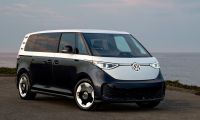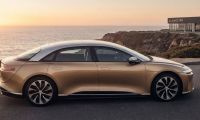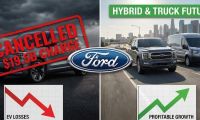The electric vehicle market is experiencing explosive growth, but unlike Tesla, many traditional car companies are struggling to show a profit on their EVs. This raises a critical question for car enthusiasts and potential EV buyers alike: when will non-Tesla car companies achieve profitability in the EV market?
The answer, sadly, isn't a simple one. There's a complex interplay of factors contributing to the current profitability challenges. Let's delve into these factors and explore potential paths for legacy automakers, alongside new players like Rivian, to achieve financial success in the electric vehicle landscape.
EV Beyond Battery Costs: The Upfront Investment Challenge
While battery costs remain a significant hurdle for EV profitability, the true challenge goes beyond just the battery pack itself. As many fans pointed out online, the entire production process for EVs requires a significant financial leap for traditional automakers. Here's a breakdown of the key cost contributors:
R&D and Logistics: Developing new EV platforms, designing efficient battery systems, and establishing robust charging infrastructure all require substantial research and development (R&D) investments. Additionally, building new production lines and sourcing new components from scratch add to the logistical complexity and cost.
New Contracts and Supplier Networks: Traditional automakers may need to establish new supplier relationships for EV-specific components, leading to potentially higher costs and longer lead times compared to established gasoline-powered vehicle supply chains.
These upfront investments significantly impact the profitability of EVs in the short term. Both industry experts and online discussions highlight this point. Tesla, despite its current profitability, also went through a period of significant financial strain during its early years, as they established their unique production processes and battery technology.
The Path to EV Profitability: Reaching the Break-Even Point
As car enthusiasts often say, "there's no replacement for displacement" when it comes to raw power, but for EVs, reaching a break-even point is crucial for financial viability. This is the point where production costs are covered by sales revenue. Here are some strategies that can help EV players reach this crucial milestone:
Economies of Scale: Developing modular EV platforms that can be adapted to different vehicle models can lead to economies of scale, reducing production costs per unit as production volume increases.
Supply Chain Optimization: Establishing strong partnerships with reliable suppliers, optimizing logistics, and streamlining production processes can significantly reduce costs over time.
Leveraging Existing Expertise: Traditional automakers can leverage their existing manufacturing expertise and established dealer networks to potentially lower production and distribution costs for EVs.
Collaboration: Key to Accelerating Progress
The transition to electric vehicles requires significant investment and innovation. Collaboration between traditional car companies, battery manufacturers, technology startups, and government agencies can accelerate progress. Sharing best practices, research findings, and potentially even co-developing technologies can lead to faster cost reductions and a quicker path to profitability for all stakeholders.
The Legacy Automaker Advantage: Profitable Gas-Powered Vehicles
A significant advantage that traditional car companies have over pure-play EV startups is their existing portfolio of gasoline-powered vehicles that continue to generate profits. This financial buffer allows them to invest in EV development and production without facing the same level of immediate financial pressure as startups that solely rely on EVs. Here's an enthusiast's perspective on this advantage: imagine Ford cranking out a bunch of their ever-popular F-150 trucks to offset losses from the Mustang Mach-E. This flexibility gives established automakers more room to experiment, innovate, and potentially take calculated risks in the EV market.
However, this advantage comes with its own challenges:
-
Legacy Costs and Infrastructure: Traditional automakers are burdened with existing manufacturing infrastructure and established supplier networks optimized for gasoline-powered vehicles. Adapting these to EVs requires significant investment and can be a slow process.
-
Internal Resistance to Change: Large organizations may have internal resistance to change, especially from departments or employees who fear job losses due to the shift towards EVs.
EV Startups: The Balancing Act of Innovation and Funding
EV startups, on the other hand, often have the advantage of being nimble and innovative. They can design and develop EVs from the ground up with a focus on efficiency and scalability. Here's a look at some of the challenges faced by EV startups:
Fundraising and Cash Flow: Startups need to constantly raise capital to fund R&D, production, and marketing. This can be a major hurdle, especially in a competitive market.
Building a Brand and Dealer Network: EV startups lack the brand recognition and established dealer networks of traditional automakers, making it difficult to compete for market share.
Finding the Right Balance: Collaboration and Strategic Partnerships
The future of the EV industry may lie in collaboration between established automakers and EV startups. Here are some ways this collaboration can benefit:
A Multifaceted Challenge: The Road to EV Profitability for All
The financial viability of the EV market hinges on several factors beyond just the selling price of individual vehicles. Upfront investments, production volume, brand recognition, and access to government incentives all play a crucial role. Here's a deeper dive into some key considerations:
- The Tesla Advantage: A Head Start in Cost and Infrastructure
Tesla's advantage in the EV market extends beyond just battery technology and established production processes. A critical aspect often overlooked is the significantly lower upfront investment they incurred during Model S development.
For instance, Tesla's purchase of the NUMMI plant from Toyota for $42 million provided them with a ready-made production facility. This stands in stark contrast to companies like Rivian and Ford who need to build or retrofit production lines from scratch, incurring billions in costs.
Tesla's total investment for Model S production, including equipment purchases and tax breaks, is estimated to be around $200 million. This is a significantly lower figure compared to the billions of dollars new entrants face today.
- The Korean Conundrum: Strong Products, Lower Sales
While Hyundai and Kia are shining examples of early success in the EV market, their story also highlights another challenge. They offer well-equipped EVs at attractive price points, and their vehicles boast functionality and practicality. However, their overall sales volume is lower compared to established players. This means it might take them longer to reach profitability despite having strong products.
The upcoming generation of EVs with platforms like EV3/4/5 and the Ioniq 3/4 might be the key to unlocking higher sales figures and subsequently, profitability for these Korean automakers.
- Government Incentives: A Double-Edged Sword
Government incentives have played a crucial role in jumpstarting the EV market. Tax breaks, rebates, and subsidies have helped make EVs more affordable for consumers, leading to increased adoption. However, these incentives are often limited or phased out over time. This can create a challenge for companies that haven't yet reached profitability, as they may need to raise prices or find other ways to offset the loss of these subsidies.
A Look at the Timeline: When Can We Expect Profitability?
While a definitive answer is elusive, experts and industry insiders offer insights into a potential timeline for EV profitability across various manufacturers:
-
Near-Term Profitability (1-3 Years): Companies like Stellantis, BYD, Tesla, and Li Auto are already demonstrating profitability in their EV segments. Additionally, companies like Geely, BMW, and potentially another European OEM may join this group in 2024.
-
Mid-Term Profitability (3-5 Years): Major state-owned Chinese OEMs like SAIC may achieve profitability within this timeframe, assuming they follow a similar path to the aforementioned companies.
-
Long-Term Profitability (5-7 Years): Korean automakers, despite having good EVs, may take longer to reach profitability due to lower sales volume. Their next generation of EVs might be the key to achieving this milestone by 2026-2028.
-
The Wildcard: Traditional American Automakers
The situation for American automakers like Ford and GM is a bit more complex. They have the advantage of existing infrastructure and established dealer networks, but they also face challenges like high upfront investments and internal resistance to change. Their success will likely depend on their ability to leverage their strengths, strategically invest in EV development, and potentially collaborate with innovative startups.
The Road Ahead: A Collaborative and Sustainable Future
The transition to a future dominated by EVs presents both challenges and opportunities. Here are some key takeaways for a prosperous and sustainable EV landscape:
-
Collaboration is Key: Collaboration between established automakers, EV startups, technology companies, and government agencies can accelerate progress, reduce costs, and foster innovation.
-
Strategic Investments: Investing in R&D, battery technology, efficient production processes, and charging infrastructure is crucial for long-term success.
-
Consumer Education and Incentives: Educating consumers about the benefits of EVs and offering continued (or even expanded) incentives can drive adoption and support the industry's growth.
-
Sustainability Throughout the Supply Chain: Ensuring ethical and sustainable practices throughout the EV supply chain, from material sourcing to battery recycling, is vital for a responsible future.
While the path to profitability for non-Tesla companies in the EV market may be longer and more complex, the future holds promise. By acknowledging the challenges, embracing collaboration, and focusing on sustainable practices, the industry can pave the way for a future where electric vehicles are not just the environmentally conscious choice, but also a financially viable one for both manufacturers and consumers alike.
Armen Hareyan is the founder and the Editor in Chief of Torque News. He founded TorqueNews.com in 2010, which since then has been publishing expert news and analysis about the automotive industry. He can be reached at Torque News Twitter, Facebook, Linkedin, and Youtube. He has more than a decade of expertise in the automotive industry with a special interest in Tesla and electric vehicles.












Comments
It doesn’t look good for…
Permalink
It doesn’t look good for legacy as they can’t build and make money on a decent drivable EV. Their only hope is to merge with Rivian before it tanks too.
During my lifetime, the auto…
Permalink
During my lifetime, the auto manufacturers were able to be profitable with vehicles selling at retail prices in the two thousand dollar range. Good solid substantial cars that were wildly popular and sold in the tens of millions per year. Then government piled regulation after regulation on them, driving up costs. Then government revved up its inflation engine, printing fiat dollars and squandering them in the trillions. Now we have cars selling, in significantly lower volumes, for prices normally reserved for 3 bedroom brick houses.
If we can rein in government, the automakers may find a path to high volumes at good profits again. But I'm not holding my breath. Once the hoi polloi learned that they can vote themselves bread and circuses, the fate of America was sealed.
You can’t turn a profit,…
Permalink
You can’t turn a profit, till you produce electric vehicles in volume. Plus, unlike Tesla, a start up company, you’ll need the 30 to 50,000 dollar vehicle, not the 70 to 90K vehicle. The upper end should be secondary. Only Pick-ups can be the higher priced vehicles
That's an easy one when…
Permalink
That's an easy one when Tesla profits are no greater than the industry average in the EV segment of the market. Every time GM, Ford, VW. Nissan etc. Sell an EV that's one less sell for Tesla.
The more people learn about…
Permalink
The more people learn about EVs, the less they want to own them. EV sales are cratering, we are watching the beginning of the end of the EV fad.
There are 7 billion people…
Permalink
There are 7 billion people on this rock, only 350 million are Americans. So many nay-sayers holding their country back to the 1960s.